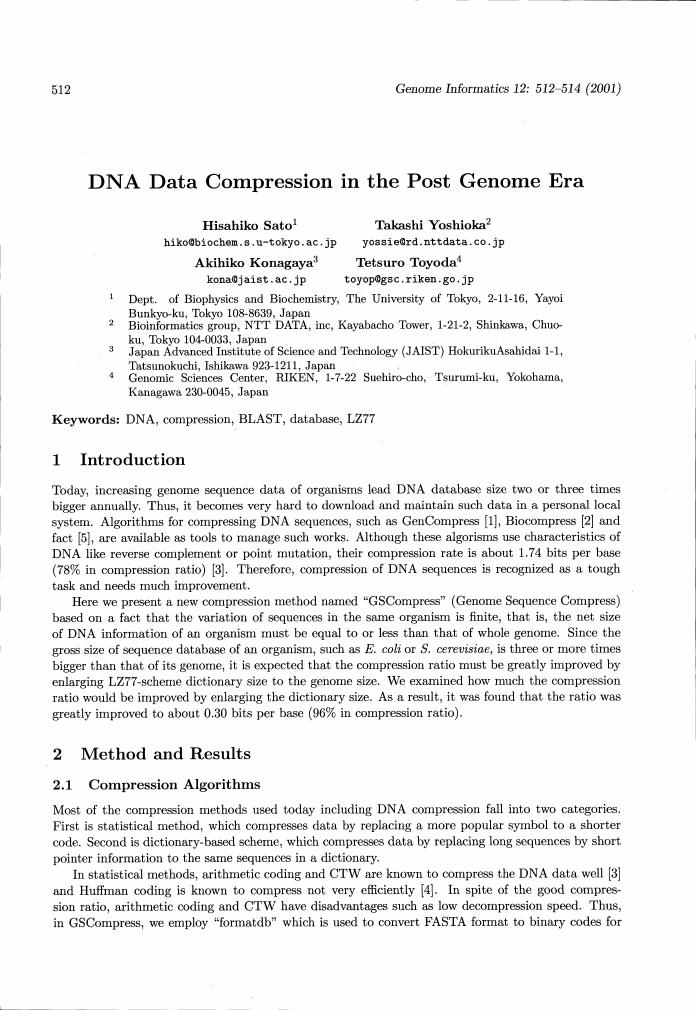- 著者
- Toshihisa Ishikawa Kohtaro Yuta Yukio Tada Akihiko Konagaya
- 出版者
- Chem-Bio Informatics Society
- 雑誌
- Chem-Bio Informatics Journal (ISSN:13476297)
- 巻号頁・発行日
- vol.17, pp.110-111, 2017-12-31 (Released:2017-12-04)
- 参考文献数
- 3
藤田稔夫氏(ふじた・としお=京都大名誉教授、医農薬化学)が今年8月22日午前11時47分、病気のため京都市内の病院で死去されました。享年88歳。昨年10月には京都大学で開催された第44回構造活性相関シンポジウムで米寿をお祝いしたところでした。藤田先生はCorwin Hansch教授(米国)と共に定量的構造活性相関の方法を確立され、医薬農薬などの多方面で分子設計に多大な影響を与えてきました。さらに、藤田先生はEMIL (Example-Mediated Innovation for Lead Evolution)の方法を開発して、人工頭脳(AI)に基づく創薬分子デザインの可能性を追求されてこられました。藤田先生の先進的な考えとアプローチは私どもの模範とするところです。この追悼文をもって藤田稔夫先生の偉業をかみしめつつ、ご冥福をお祈り申し上げます。
2 0 0 0 OA DNA Data Compression in the Post Genome Era
- 著者
- Hisahiko Sato Takashi Yoshioka Akihiko Konagaya Tetsuro Toyoda
- 出版者
- Japanese Society for Bioinformatics
- 雑誌
- Genome Informatics (ISSN:09199454)
- 巻号頁・発行日
- vol.12, pp.512-514, 2001 (Released:2011-07-11)
- 参考文献数
- 5
- 著者
- Bharata Kalbuaji Y-H. Taguchi Akihiko Konagaya
- 出版者
- Chem-Bio Informatics Society
- 雑誌
- Chem-Bio Informatics Journal (ISSN:13476297)
- 巻号頁・発行日
- vol.19, pp.32-55, 2019-09-30 (Released:2019-10-03)
- 参考文献数
- 47
Gene expression analysis for understanding cancer cell development is a basic, but an important step, to further our knowledge in cancer research. We may also be interested in understanding gene interactions that may lead to cancer development. One of the most important interactions is a regulatory interaction that involves transcription factor genes. In this research, we are attempting to construct a new regulatory network that imitates the transcription and translation processes of mRNA. We construct this network from four different cancer types: bile-duct cancer (BDC), lung adenocarcinoma (LUAD), colorectal cancer (CRC), and hepatocyte carcinoma (HCC). We also integrate differential expression data to obtain the interactions among differentially expressed genes. We then try to find intersecting sub-networks that exist across all cancer types. We believe that the transcription factor genes found in intersection sub-networks may reveal an important mechanism that affects cancer cell growth. In this research, we found that genes, such as those in the TEAD4, IRX5, HMGA1, and E2F gene family and the SOX gene family, are found in the enrichment analysis of the intersection sub-network obtained from multiple cancer data-sets. These genes point us toward dysregulation of the cell cycle, cell division, and cell proliferation mechanisms in cancer cells. These genes may become new cancer drug targets for cancer treatment.
2 0 0 0 OA AIと遺伝子情報処理 (<特集>AIチャレンジ)
- 著者
- 小長谷 明彦 Akihiko Konagaya 北陸先端科学技術大学院大学知識科学研究科 School of Knowledge Science Japan Advanced Insititute of Science and Technology Hokuriku
- 雑誌
- 人工知能学会誌 = Journal of Japanese Society for Artificial Intelligence (ISSN:09128085)
- 巻号頁・発行日
- vol.13, no.1, pp.38-40, 1998-01-01
